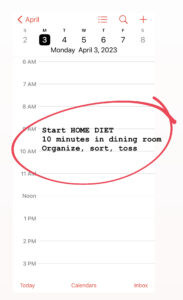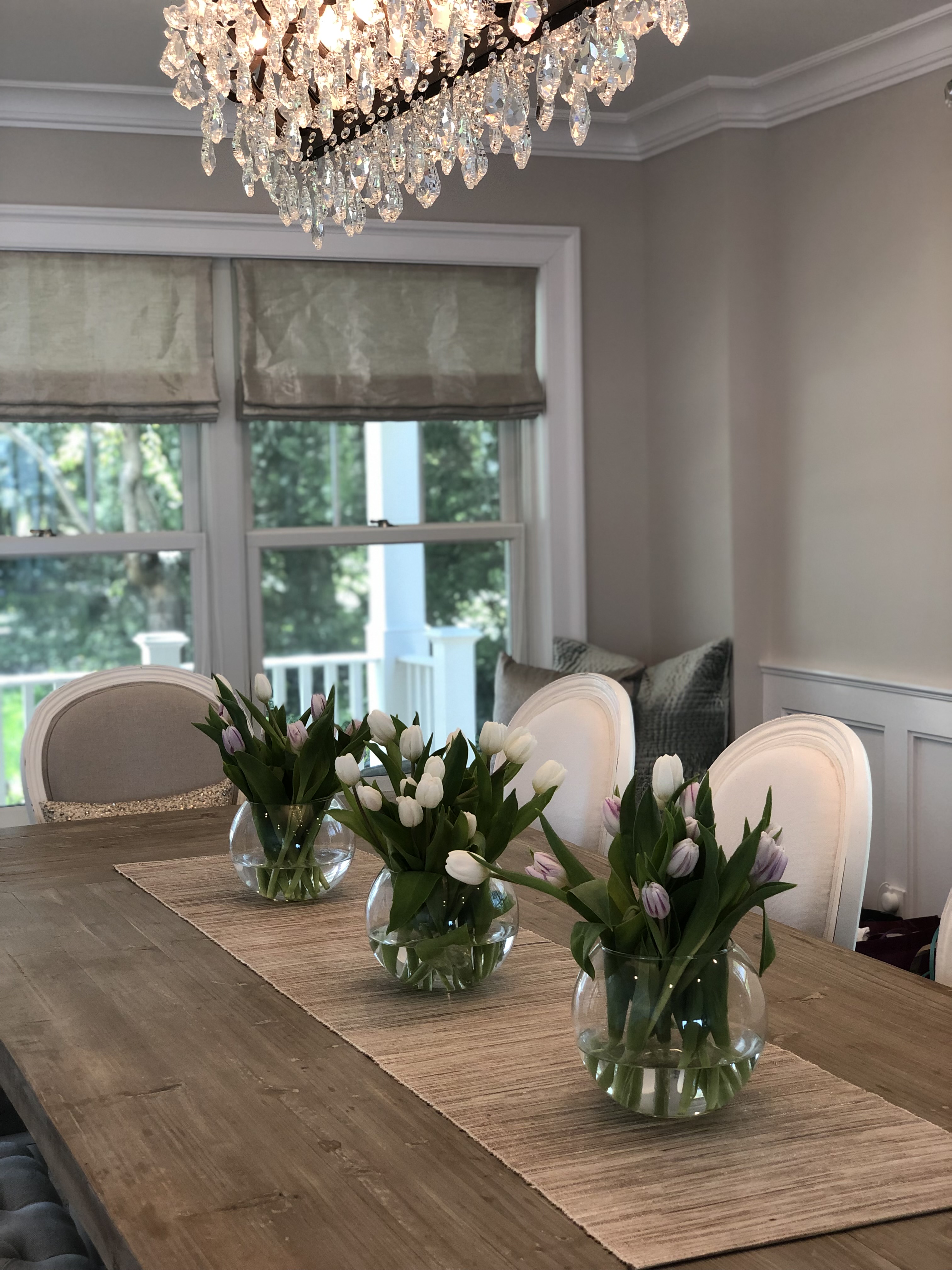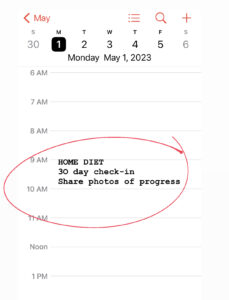Cleaning At Home Can Be Very Overwhelming, So I’m Going to Help You Lose Some “FAT”, In Just 30 Days!
Feeling overwhelmed, lots to tackle? Not to worry — start small, do this simple process for only one month. From living rooms, closets, cabinets, junk drawers and even your digital inboxes we can all stand to shed some weight at home … and in our minds.
Home Diet is about removing the Furniture and Trash (FAT) from your life. This is one diet that is not about eating less or depriving yourself of food. It’s about creating a space in your home that is supportive of your health and well-being. When you have less stuff, you have more space to move around, to breathe, and to relax. The great thing about this diet is it’s free and you don’t need an organizational professional to help you.
If you’re ready to start shedding the extra “FAT” from your home, follow these simple steps:
- Start on a Monday
- Curate Don’t Decorate
- Don’t Cheat
- Cure Your Coffee Table from Craving Clutter
- Weigh Your Progress
So, what are you waiting for? Let’s get started!
Step #1: Start on a Monday

There’s no better way to start your home diet plan than on a Monday. Every Monday is like a “New Year” because it is an opportunity to start fresh and make new goals.
Carve out at least 10 minutes a day for 30 days to a slimmed-down home. We schedule our haircuts, gym sessions, nails, and just about everything in between, so why not schedule some time for yourself?
Scheduling 10 minutes a day for 30 days to a slimmed-down home may seem like a daunting task, but it is quite achievable. By focusing on one room at a time, you can make significant progress in a short amount of time.
Here are some more quick tips:
- Start with the easiest room first. This will give you a sense of accomplishment and motivate you to keep going.
- Don’t try to do everything at once. Just focus on one area at a time.
- If you come across something that you’re not sure what to do with, put it in a box to sort through later
Why 30 days?
Research has shown that good habits can be formed in 30 days. The 30-day habit formation theory is based on the work of Dr. Phillippa Lally, a senior research fellow at University College London.
In her study, Lally found that participants who performed a new behavior for 30 days were more likely to continue that behavior after the 30 days were up than those who only performed the behavior for 21 days.
Step #2: Curate Don’t Decorate
![]() When you think like a curator, you realize what pieces should be removed to create a more cohesive and well-edited space. You’re able to easily remove anything that doesn’t fit the overall look and feel of the room.
When you think like a curator, you realize what pieces should be removed to create a more cohesive and well-edited space. You’re able to easily remove anything that doesn’t fit the overall look and feel of the room.
As the curator of my house, I would only select items that help tell a story or convey a specific message. I would choose items that are meaningful to me and that represent my life and interests.
I would also choose items that are unique and that would be interesting to visitors. For example, I might select a piece of art that I created, a book that I love, or a toy that I played with as a child.
Edit your world, Clean, Organize, Donate and Store
Edit your world by removing anything that doesn’t belong:
- Remove anything that is damaged or broken. Don’t think about it, just get rid of it.
Clean your space as you move through this process:
- Dust and vacuum your space as you go along. Keeping your space clean and tidy is key.
Organize your items:
- Keep your future self happy. Take time to organize any remaining items.
Donate items:
- Donate items that you no longer need or use to those who could benefit from them. Many organizations accept donations of clothes, toys, furniture, and other items.
Store items in a safe and organized place:
- Label items that you store, so you know what is in each container.
Pro Tip: Don’t just move a pile of projects from one corner of the room to another. Get rid of the clutter, instead of trying to hide it!
Step#3: Don’t Cheat
![]() Don’t try to contain the clutter by purchasing storage bins! This is cheating on your diet!
Don’t try to contain the clutter by purchasing storage bins! This is cheating on your diet!
Try to get rid of some, if not most of the clutter.
It’s important to remember that home dieting is not just about putting things away. It’s also about getting rid of items that you no longer need or use.
Start by sorting through your belongings and identifying items that you can get rid of. Once you’ve identified these items, you can donate them, sell them, or trash them.
Photo journaling can be a helpful starting point for getting rid of items, as it allows you to see what you have and what you don’t need.
Pro tip: For example, taking photos of kids’ art projects is a great way to keep the memory of them without having to keep the actual items.
More quick tips for containing the clutter:
- Start with one room or area at a time.
- Set a timer for 10 minutes and work until the timer goes off.
- Don’t be afraid to get rid of sentimental items. If you’re struggling to let go of something, take a photo of it or make a memory of it in some other way.
If you find your surfaces getting clutters again, rethink having that surface in your room. For example: if you have an end table that’s main purpose is to hold a table lamp on it and that end table is a constant place were clutter gathers, remove the end table and the lamp and replace it with just a floor lamp.
No table equals no clutter — problem solved!
Step #4: Cure Your Coffee Table from Craving Clutter
![]() Looking for motivation? Get motivated by visualizing the finished space. This will help you stay on track and achieve your desired outcome.
Looking for motivation? Get motivated by visualizing the finished space. This will help you stay on track and achieve your desired outcome.
I suggest starting with your coffee table because it is the constant centerpiece and “command center” of most living rooms. It is also a common place for clutter to accumulate, so decluttering it first can make a big difference in the overall look and feel of your space.
Here are some tips for slimming down your coffee table:
- Start by clearing off any items that are not needed on the table. This includes things like remotes, games, and snacks.
- Next, organize the items that you do want to keep on the table. You can do this by category, such as books, magazines, or candles.
- If you have any items that are not used very often, you can store them in a box or basket. This will help keep your coffee table clutter-free.
- Finally, take a few minutes to vacuum or dust your coffee table. This will make it look clean and refreshed.
Think Portion Control: You wouldn’t have so much food that it spills off your plate and onto the table. Only allow a few selected items to remain on your coffee table. This easy tip will make your coffee table look more organized and less cluttered.
Next Step: Once your coffee table is complete, move on to your kitchen island. Remember it’s an island, not a desk!
Step #5: Weigh Your Progress
 Once a week, take a few minutes to check in with yourself and how you’re feeling about your home dieting progress. Set a reminder on your calendar and take stock of what you’ve accomplished and what you still need to do.
Once a week, take a few minutes to check in with yourself and how you’re feeling about your home dieting progress. Set a reminder on your calendar and take stock of what you’ve accomplished and what you still need to do.
If you’re feeling overwhelmed, don’t be afraid to take a break or ask for help from a friend or family member.
Once an area in your home is looking and feeling “lighter”, monitor and maintain that area to make sure old habits aren’t happening again. You can do this by journaling or through photo journaling and sharing on social media. Enlist your family, and pals to join the mission.
Pro Tip: Taking photos of your progress and sharing with friends and family will help you stay motivated and accountable.
As you move through your home diet regimen, remember to keep your eyes open for areas that could use some extra attention.
Remember, home dieting is a journey, not a destination. There will be times when you feel like you’re making no progress, but just keep going. The more you declutter, the easier it will become. And once your home is looking better, you’ll be amazed at how you’ll be feeling better.
Francesco Bilotto is a television design and entertaining expert who has appeared on many national and local news programs, as well as in many magazines. He has also appeared on The View, Today, and Good Morning America.
Bilotto is known for his unique approach to home design, which he calls the “home diet.” The home diet is a holistic approach to home design that focuses on creating spaces that are both functional and beautiful. Bilotto believes that the home should reflect the people who live there, and he works with his clients to create spaces that are both unique and comfortable.
Bilotto is a passionate advocate for home design and believes that everyone deserves to live in a space that they love. He is committed to helping people create homes that are both beautiful and functional, and he is proud to have helped people across the globe.